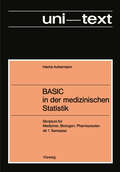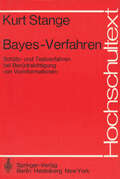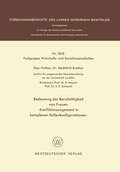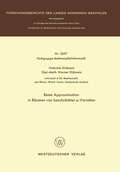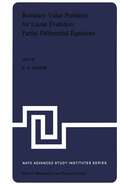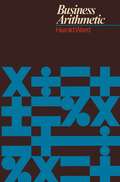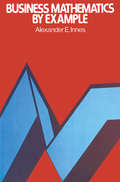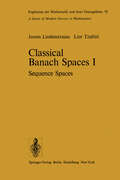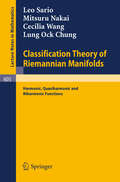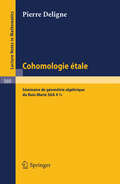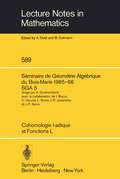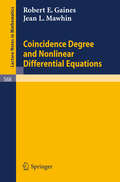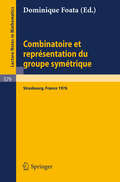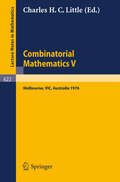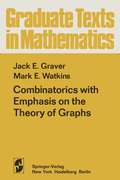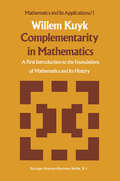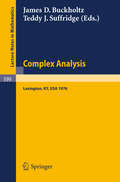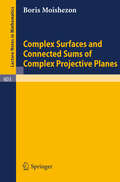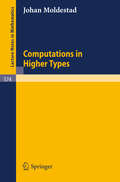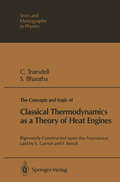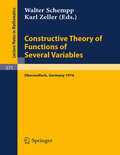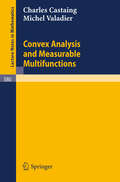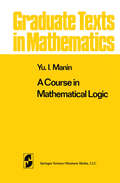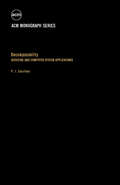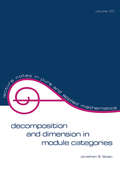- Table View
- List View
BASIC in der medizinischen Statistik: Skriptum für Mediziner, Biologen, Pharmazeuten ab 1. Semester
by Hanns AckermannBayes-Verfahren: Schätz- und Testverfahren bei Berücksichtigung von Vorinformationen (Hochschultext)
by K. StangeBedeutung der Berufstätigkeit von Frauen: Konfliktmanagement in komplexen Rollenkonfigurationen (Forschungsberichte des Landes Nordrhein-Westfalen #2618)
by Mechthild BrothunBeste Approximation in Räumen von beschränkter p-Variation (Forschungsberichte des Landes Nordrhein-Westfalen #2697)
by Gabriele DickmeisBoundary Value Problems for Linear Evolution Partial Differential Equations: Proceedings of the NATO Advanced Study Institute held in Liège, Belgium, September 6–17, 1976 (Nato Science Series C: #29)
by H. G. GarnirMost of the problems posed by Physics to Mathematical Analysis are boundary value problems for partial differential equations and systems. Among them, the problems concerning linear evolution equations have an outstanding position in the study of the physical world, namely in fluid dynamics, elastodynamics, electromagnetism, plasma physics and so on. This Institute was devoted to these problems. It developed essentially the new methods inspired by Functional Analysis and specially by the theories of Hilbert spaces, distributions and ultradistributions. The lectures brought a detailed exposition of the novelties in this field by world known specialists. We held the Institute at the Sart Tilman Campus of the University of Liege from September 6 to 17, 1976. It was attended by 99 participants, 79 from NATO Countries [Belgium (30), Canada (2), Denmark (I), France (15), West Germany (9), Italy (5), Turkey (3), USA (14)] and 20 from non NATO Countries [Algeria (2), Australia (3), Austria (I), Finland (1), Iran (3), Ireland (I), Japan (6), Poland (1), Sweden (I), Zair (1)]. There were 5 courses of_ 6_ h. ollI'. s~. 1. nL lJ. , h. t;l. l. I. rl"~, 1. n,L ,_ h. t;l. l. I. r. !'~ , ?_ n. f~ ?_ h,,
Classical Banach Spaces I: Sequence Spaces (Ergebnisse der Mathematik und ihrer Grenzgebiete. 2. Folge #92)
by J. Lindenstrauss L. TzafririThe appearance of Banach's book [8] in 1932 signified the beginning of a syste matic study of normed linear spaces, which have been the subject of continuous research ever since. In the sixties, and especially in the last decade, the research activity in this area grew considerably. As a result, Ban:ach space theory gained very much in depth as well as in scope: Most of its well known classical problems were solved, many interesting new directions were developed, and deep connections between Banach space theory and other areas of mathematics were established. The purpose of this book is to present the main results and current research directions in the geometry of Banach spaces, with an emphasis on the study of the structure of the classical Banach spaces, that is C(K) and Lip.) and related spaces. We did not attempt to write a comprehensive survey of Banach space theory, or even only of the theory of classical Banach spaces, since the amount of interesting results on the subject makes such a survey practically impossible.
Classification Theory of Riemannian Manifolds: Harmonic, Quasiharmonic and Biharmonic Functions (Lecture Notes in Mathematics #605)
by S. R. Sario M. Nakai C. Wang L. O. ChungCohomologie Etale: Séminaire de Géométrie Algébrique du Bois-Marie SGA 4 1/2 (Lecture Notes in Mathematics #569)
by Pierre Deligneltats – avec une généralité minimale, souvent insuffisante pour les applications –et une idée de leur démonstration. Pour des résultats complets, ou des démonstrationsdétaillées, SGA 4 reste indispensable.Le “Rapport sur la formule des traces” contient une démonstration complété dela formule des traces pour l’endomorphisme de Frobenius. La démonstration est celledonnée par Grothendieck dans SGA 5, élaguée de tout détail inutile. Ce rapportdevrait permettre à utilisateur d’oublier SGA 5, qu’on pourra considérer comme unesérie de digression, certaines très intéressantes. Son existence permettra de publierprochainement SGA 5 tel quel. Il est complété par l’exposé “Applications de laformule des traces aux sommes trigonométriques” qui explique comment la formuledes traces permet l’étude de sommes trigonométriques, et donne des exemples..
Cohomologie l-adique et Fonctions L: Séminaire de Géométrie Algébrique du Bois-Marie 1965-66, SGA 5 (Lecture Notes in Mathematics #589)
by Ionel Bucur Alexander Grothendieck Christian Houzel Luc Illusie Jean-Pierre Jouanolou Jean-Pierre SerreCoincidence Degree and Nonlinear Differential Equations (Lecture Notes in Mathematics #568)
by R. E. Gaines J. L. MawhinCombinatoire et Representation du Groupe Symetrique: Actes de la Table Ronde du C.N.R.S., tenue a l'Universite Louis Pasteur, Strasbourg, 26 au 30 avril 1976 (Lecture Notes in Mathematics #579)
by D. FoataCombinatorial Mathematics V.: Proceedings of the Fifth Australian Conference, Held at the Royal Melbourne Institute of Technology, August 24 - 26, 1976. (Lecture Notes in Mathematics #622)
by C. H. C LittleCombinatorics with Emphasis on the Theory of Graphs (Graduate Texts in Mathematics #54)
by J. E. Graver M. E. WatkinsCombinatorics and graph theory have mushroomed in recent years. Many overlapping or equivalent results have been produced. Some of these are special cases of unformulated or unrecognized general theorems. The body of knowledge has now reached a stage where approaches toward unification are overdue. To paraphrase Professor Gian-Carlo Rota (Toronto, 1967), "Combinatorics needs fewer theorems and more theory. " In this book we are doing two things at the same time: A. We are presenting a unified treatment of much of combinatorics and graph theory. We have constructed a concise algebraically based, but otherwise self-contained theory, which at one time embraces the basic theorems that one normally wishes to prove while giving a common terminology and framework for the develop ment of further more specialized results. B. We are writing a textbook whereby a student of mathematics or a mathematician with another specialty can learn combinatorics and graph theory. We want this learning to be done in a much more unified way than has generally been possible from the existing literature. Our most difficult problem in the course of writing this book has been to keep A and B in balance. On the one hand, this book would be useless as a textbook if certain intuitively appealing, classical combinatorial results were either overlooked or were treated only at a level of abstraction rendering them beyond all recognition.
Complementarity in Mathematics: A First Introduction to the Foundations of Mathematics and Its History (Mathematics and Its Applications #1)
by W. KuykAs long as algebra and geometry The unreasonable effectiveness of proceeded along separate paths, mathematics in science . . . Eugene Wigner their advance was slow and their applications limited. But when these sciences joined Weil, if you knows of a better 'oie, company, they drew from each go to it. Bruce Bairnsfather other fresh vitality and thence forward marched on at a rapid pace What is now proved was once only towards perfeetion. imagined. Wi1liam Blake J oseph Louis Lagrange Growing specialization and diversification have brought a host of monographs and textbooks on increasingly specialized topics. However, the 'tree' of knowledge of mathematics and related fields does not grow only by putting forth new branches. It also happens, quite often in fact, that branches which were thought to be completely disparate are suddenly seen to be related. This series of books, Mathematics and Its Applications, is devoted to such (new) interrelations as exempla gratia: - a central concept which plays an important role in several different mathematical and/or scientific specialized areas; Editor's Preface 8 - new applications of the results and ideas from one area of scientific endeavor into another; - influences which the results, problems and concepts of one field of inquiry have and have had on the development of another. With books on topics such as these, of moderate length and price, which are stimulating rather than definitive, intriguing rather than encyclopaedic, we hope to contribute something towards better communication among the practitioners in diversified fields.
Complex Analysis. Kentucky 1976: Proceedings of the Conference Held at the University of Kentucky, May 18 - 22, 1976 (Lecture Notes in Mathematics #599)
by J. D. Buckholtz T. J. SuffridgeComplex Surfaces and Connected Sums of Complex Projective Planes (Lecture Notes in Mathematics #603)
by B. MoishezonThe Concepts and Logic of Classical Thermodynamics as a Theory of Heat Engines: Rigorously Constructed upon the Foundation Laid by S. Carnot and F. Reech (Theoretical and Mathematical Physics)
by Clifford A. Truesdell Subramanyam BharathaMon but n'a jamais be de m'occuper des ces matieres comme physicien, mais seulement comme /ogicien ... F. REECH, 1856 I do not think it possible to write the history of a science until that science itself shall have been understood, thanks to a clear, explicit, and decent logical structure. The exuberance of dim, involute, and undisciplined his torical essays upon classical thermodynamics reflects the confusion of the theory itself. Thermodynamics, despite its long history, has never had the benefit of a magisterial synthesis like that which EULER gave to hydro dynamics in 1757 or that which MAXWELL gave to electromagnetism in 1873; the expositions in the works of discovery in thermodynamics stand a pole apart from the pellucid directness of the notes in which CAUCHY presented his creation and development of the theory of elasticity from 1822 to 1845. Thermodynamics was born in obscurity and disorder, not to say confusion, and there the common presentations of it have remained. With this tractate I aim to provide a simple logical structure for the classical thermodynamics of homogeneous fluid bodies. Like any logical structure, it is only one of many possible ones. I think it is as simple and pretty as can be.
Constructive Theory of Functions of Several Variables: Proceedings of a Conference Held at Oberwolfach, April 25 - May 1, 1976 (Lecture Notes in Mathematics #571)
by W. Schempp K. ZellerConvex Analysis and Measurable Multifunctions (Lecture Notes in Mathematics #580)
by C. Castaing M. ValadierA Course in Mathematical Logic (Graduate Texts in Mathematics #53)
by Yu.I. Manin1. This book is above all addressed to mathematicians. It is intended to be a textbook of mathematical logic on a sophisticated level, presenting the reader with several of the most significant discoveries of the last ten or fifteen years. These include: the independence of the continuum hypothe sis, the Diophantine nature of enumerable sets, the impossibility of finding an algorithmic solution for one or two old problems. All the necessary preliminary material, including predicate logic and the fundamentals of recursive function theory, is presented systematically and with complete proofs. We only assume that the reader is familiar with "naive" set theoretic arguments. In this book mathematical logic is presented both as a part of mathe matics and as the result of its self-perception. Thus, the substance of the book consists of difficult proofs of subtle theorems, and the spirit of the book consists of attempts to explain what these theorems say about the mathematical way of thought. Foundational problems are for the most part passed over in silence. Most likely, logic is capable of justifying mathematics to no greater extent than biology is capable of justifying life. 2. The first two chapters are devoted to predicate logic. The presenta tion here is fairly standard, except that semantics occupies a very domi nant position, truth is introduced before deducibility, and models of speech in formal languages precede the systematic study of syntax.
Decomposability: Queueing and Computer System Applications
by P. J. CourtoisDecomposability: Queueing and Computer System Applications presents a set of powerful methods for systems analysis. This 10-chapter text covers the theory of nearly completely decomposable systems upon which specific analytic methods are based.The first chapters deal with some of the basic elements of a theory of nearly completely decomposable stochastic matrices, including the Simon-Ando theorems and the perturbation theory. The succeeding chapters are devoted to the analysis of stochastic queuing networks that appear as a type of key model. These chapters also discuss congestion problems in information processing systems, which could be studied by the queuing network models. A method of analysis by decomposition and aggregation for these models is proposed. Other chapters highlight the problem of computer system performance evaluation, specifically the analysis of hardware and software of the dynamic behavior of computer systems and user programs. These topics are followed by a description of an aggregative model of a typical multiprogramming time-sharing computer system. The last chapter examines the existing affinity between the concept of aggregate in nearly completely decomposable structures and the notions of module and level of abstraction so frequently invoked in computer system design and software engineering. This book will prove useful to both hardware and software designers and engineers, as well as scientists who are investigating complex systems.
Decomposition and Dimension in Module Categories
by Jonathan S. GolanThis book examines the notions of dimension and decomposition for module categories. It discusses some basic properties of quasidecomposition functions and the complete lattice of all quasidecomposition functions taking values in a fixed given lattice.
